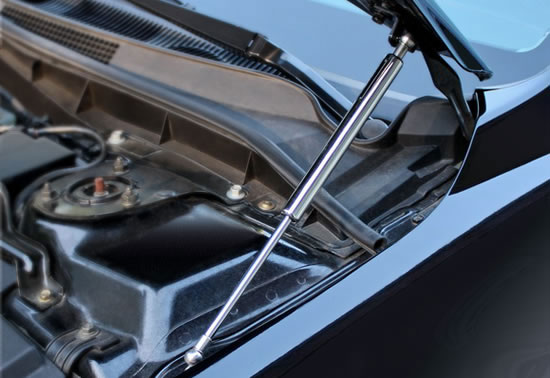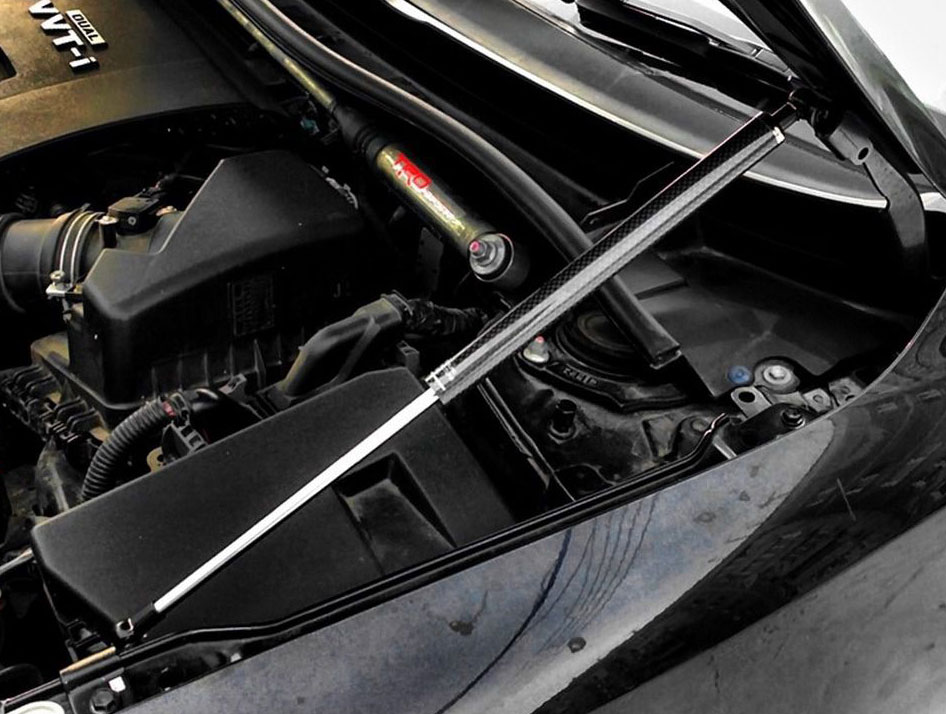
In many modern cars and special equipment, the place of the classic hood stop in the form of a rod is occupied by special shock absorbers (or gas springs). Read all about hood shock absorbers, their purpose, existing types and design features, maintenance and repair in the article.
Purpose of the hood shock absorber
In modern vehicles and other equipment, the most serious attention is paid to human safety during operation and maintenance. Relatively new tools that ensure safety and convenience in maintenance and repair of equipment include various shock absorbers (gas stops) of the hood. This simple component began to be installed on cars, tractors, special equipment and various machines relatively recently, but has already gained recognition and, probably, in the future will completely replace inconvenient and not very reliable bar stops.
A hood shock absorber or, as it is often called, a gas stop is a device for safely opening / closing the hood and keeping it open. This part solves several problems:
- Assistance in opening the hood - the stop raises the hood, so the car owner or mechanic does not have to make an effort and pull his hands up;
- Shock-free opening and closing of the hood - the shock absorber prevents shocks that occur in the extreme positions of the hood;
- Reliable holding of the hood in the open position.
In addition, the shock absorber protects the hood itself and the adjacent sealing and body parts from deformations that can occur during impacts. Therefore, the presence of a hood shock absorber increases the life of these components, and also significantly increases the ease of operation, maintenance and repair of vehicles equipped with it.
Types and principle of operation of hood shock absorbers (gas springs)
It should be said right away that all hood shock absorbers used today are gas springs, identical in design and principle of operation to furniture gas springs (or gas lifts). However, in technology, unlike furniture production, two types of shock absorbers are used:
- Gas (or pneumatic) with dynamic damping;
- Gas-oil (or hydropneumatic) with hydraulic damping.
Gas shock absorbers are most simply arranged. They are a cylinder inside which there is a piston on the rod. The outlet of the rod from the cylinder is hermetically sealed with a gland assembly to prevent gas leakage. In the walls of the cylinder there are channels through which, during the operation of the shock absorber, gas flows from one cavity to another. The cylinder is filled with gas (usually nitrogen) at high pressure.
The gas spring works as follows. When the hood is closed, the shock absorber is compressed, as a result of which there is a certain volume of gas under high pressure in the above-piston space. When opening the hood locks, the gas pressure in the shock absorber exceeds the weight of the hood, as a result of which it rises. At a certain point, the piston crosses the air channels through which the gas enters the piston space, as a result of which the pressure in the above-piston space drops and the speed of lifting the hood decreases. With further movement, the piston closes the channels, and at the top of the hood opening, the piston smoothly stops with the resulting gas layer. When the hood is closed, everything happens in reverse order, but the initial impulse for the hood to move is provided by human hands.
Dynamic damping is implemented in the gas shock absorber. The lifting and lowering of the hood due to the constant drop in gas pressure occurs at a decreasing speed, and at the final stage the hood smoothly stops due to the stop of the piston in the gas "pillow".
Hydropneumatic springs have the same device, but with one difference: it contains a certain amount of oil, in which the piston is immersed when the hood is raised. Hydraulic damping is implemented in these shock absorbers, since the impact of the hood when the extreme positions are reached is extinguished by oil due to its viscosity.
Hydropneumatic shock absorbers, unlike pneumatic shock absorbers, raise the hood faster and practically without reducing speed throughout the area, but pneumatic shock absorbers perform a smoother opening with less force in extreme positions. Despite these differences, today both types of gas springs are approximately the same distribution.

Design features and characteristics of hood shock absorbers
Structurally, all hood shock absorbers (gas springs or stops) are the same. They are a cylinder, from one side of which the piston rod emerges. At the closed end of the cylinder and the end of the rod, ball joints are made, with the help of which the shock absorber is attached to the hood and body. Usually, hinges are built on the basis of ball pins with threaded tips, the ball part is held by a lock on the shock absorber, and with the help of a threaded part and a nut, the pin is mounted on the bracket.
Usually, to hold the hood, it is enough to have one shock absorber, but in many cars, tractors and other equipment with heavy hoods, two shock absorbers are used at once.
Installation of shock absorbers is carried out in a place where, when the rod is fully extended, the hood is fully opened. In this case, the orientation of the shock absorber relative to the hood and body is performed depending on its type:
- Pneumatic (gas) shock absorbers - can be installed in any position, both with the rod down (to the body) and the rod up (to the hood). Orientation in space does not affect their work;
- Hydropneumatic (gas-oil) shock absorbers - should be installed in the "rod down" position, since in this case the oil layer will always be located at the bottom of the shock absorber, which ensures its most efficient operation.
The gas stop of the hood is a relatively simple part, however, it also requires compliance with some rules of operation and maintenance.
Issues of maintenance and repair of hood shock absorbers
To extend the life of the hood gas stop, you must follow a few simple recommendations:
- Do not bring the hood to the top point by hand force - the hood should open only under the force created by the shock absorber;
- In the winter season, you need to raise and close the hood smoothly and without jerks, helping with your hands, otherwise there is a risk of damaging the frozen shock absorber;
- Shock absorbers are not allowed to be disassembled, subjected to shock, excessive heating, etc. - this is fraught with serious injuries, since there is a gas under high pressure inside.
In the event of a breakdown of the shock absorber, when it is depressurized or oil leaks (which affects its operation), the part should be replaced in the assembly. When buying a new shock absorber, it is necessary to rely on the manufacturer's recommendations, but it is quite acceptable to replace it with parts that are similar in characteristics. The main thing is that the shock absorber develops sufficient force to raise the hood and has sufficient length.
Replacing the hood shock absorber comes down to unscrewing and tightening two nuts, in some cases it may be necessary to replace the brackets. When installing a new shock absorber, it is necessary to comply with the requirements for its orientation, that is, depending on the type, put the rod up or the rod down. Installation errors are unacceptable, as this will lead to improper operation of the shock absorber and increase the risk of injury when performing work in the engine compartment.
With proper operation of the hood shock absorber and with its correct repair, the operation of a car, tractor or other type of equipment will be comfortable and safe in all situations.
Post time: Aug-27-2023
